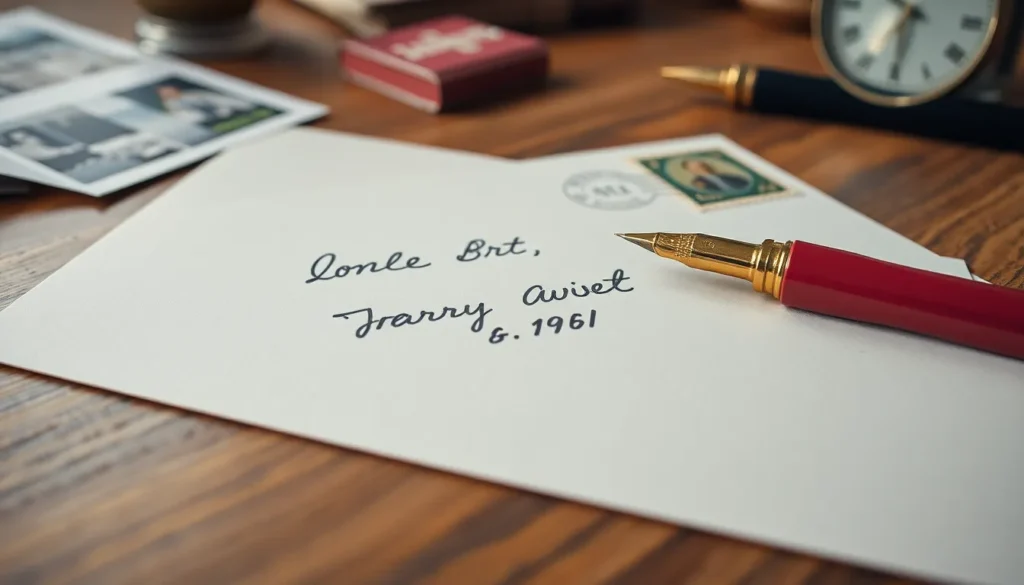Sending a letter in the UK isn’t just about putting pen to paper; it’s a delicate art form that can make or break your correspondence. Picture this: you’ve crafted the perfect message, only to have it lost in the postal abyss because the address was a hot mess. That’s right! An incorrectly written address can turn your heartfelt letter into a mysterious package that ends up who-knows-where.
Table of Contents
ToggleUnderstanding Envelope Addressing
Addressing an envelope correctly ensures prompt delivery and avoids potential mishaps in the postal system. Attention to detail in this area enhances the efficiency of correspondence.
Importance of Proper Addressing
Proper addressing significantly impacts the successful delivery of mail. A clearly written address helps postal workers navigate their routes effectively. Missing or incorrect information may lead to delays or misdelivery. Using the correct format simplifies sorting at postal facilities. Adhering to guidelines fosters better communication between senders and recipients. Clear addresses contribute to a positive mailing experience and build trust in postal services.
Common Mistakes to Avoid
Avoiding common errors in envelope addressing enhances delivery success. Omitting the recipient’s name, for example, can create confusion. Writing addresses inaccurately, such as misspelling street names, complicates the delivery process. Failing to include the postcode increases the likelihood of delays. Incorrect placement of the return address can lead to lost mail. Remembering to use legible handwriting ensures that every detail is discernible. By steering clear of these pitfalls, senders improve the chances of timely delivery.
Components of an Address

Understanding the components of an address ensures effective mail delivery in the UK. Each part plays a critical role in guiding postal workers to the intended recipient.
Recipient Name
The recipient’s name must be clearly written at the top of the address. Include the full name, either an individual or an organization. Avoid using nicknames to prevent confusion. A complete name helps postal workers verify deliveries without going through unnecessary steps. If addressing a business, ensure the company name appears prominently. Titles or salutations like “Mr.” or “Ms.” can enhance personalization but aren’t mandatory. Always double-check the spelling to prevent delays.
Street Address
The street address follows the recipient’s name and includes the house number and street name. Proper formatting is essential for accuracy. Include any apartment or flat numbers where applicable. Avoid abbreviations that may confuse postal workers. Each component should be legible and distinct. For example, “123 High Street” clearly outlines both the number and street, making it easier for postal services to locate the address. Place this information on one line if possible, enhancing clarity.
City and Postcode
The city name and postcode conclude the address, providing geographic context. Always include the full name of the city, as this identifies the mailing area accurately. The postcode secures the delivery point, narrowing down the search for postal workers. For example, “London SW1A 1AA” effectively directs mail to a specified location. Ensure the postcode format follows UK standards. This enhances the likelihood of swift and accurate delivery by postal services.
Formatting the Address
Properly formatting an address ensures efficient delivery in the UK. Following a few guidelines enhances clarity and prevents delivery issues.
Placement on the Envelope
Positioning the address correctly is crucial. Center the address on the front of the envelope, leaving sufficient space on the left for any return address. The recipient’s name appears at the top, followed by the street address on the next line. Include the city name on a new line, followed by the postcode. Maintain a balanced look and avoid placing the address too close to the edges for easy readability by postal workers.
Font and Size Recommendations
Choosing the right font and size enhances visibility. Opt for a standard, legible font such as Arial or Helvetica. A font size of 10 to 12 points ensures the text is clear without becoming overly large. Avoid cursive or decorative styles that can reduce readability. Consider using all capital letters for the street address and postcode to improve clarity, especially if handwriting. Proper formatting contributes significantly to successful delivery.
Special Considerations
Addressing envelopes correctly involves several unique aspects that ensure effective communication. Both international and domestic mail requires careful attention to address formats.
Sending International Mail
When sending mail to other countries, specific addressing formats become crucial. Each country has its own guidelines, which may differ significantly from UK standards. The recipient’s country should be clearly stated in capital letters on the last line. It’s essential to include the correct postal code and city to avoid delays. Additionally, check customs requirements for items sent internationally, as some may require additional documentation that must accompany the envelope. Properly addressing international mail enhances the chance of swift delivery.
Addressing for Different Types of Recipients
Addressing envelopes varies depending on the recipient type. For individual addresses, full names are prioritized, avoiding abbreviations. Business addresses should include the company name followed by the attention line, indicating the intended individual’s name if necessary. For organizations, always follow the business’s addressing conventions, which may enhance delivery reliability. Academic institutions benefit from detailed addressing, including department names. Adaptations ensure that the postal service correctly processes and delivers the mail efficiently.
Addressing an envelope correctly in the UK is vital for ensuring that letters reach their intended recipients without delays. By paying attention to detail and adhering to the proper format, senders can significantly enhance the efficiency of their correspondence. Each component of the address plays an essential role in guiding postal workers, making clarity and accuracy paramount.
Avoiding common mistakes and following the outlined guidelines will not only improve the likelihood of timely delivery but also foster effective communication. Whether sending domestic or international mail, understanding these principles is key to successful correspondence. With the right approach, anyone can master the art of envelope addressing.




